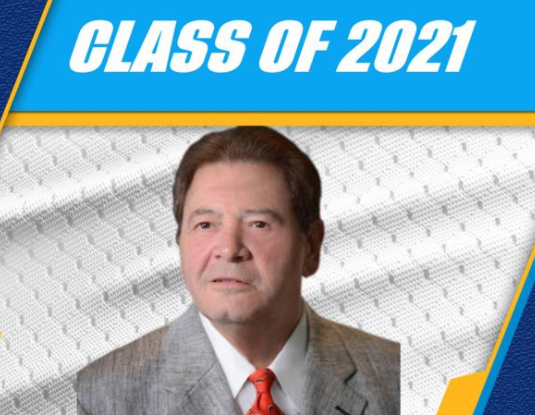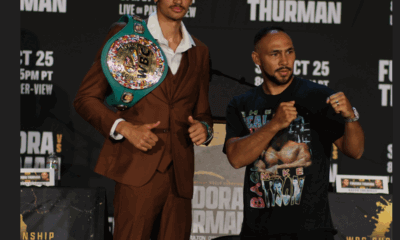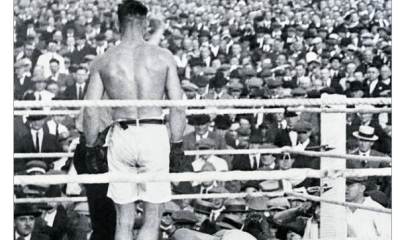Featured Articles
Les Bonano, Mr. Boxing in New Orleans, Enters the NOLA Sports Hall of Fame

He is perhaps the final ruler of what remains of a fraying and depleted boxing kingdom in the formerly great fight town of New Orleans. For 50-plus years Les Bonano has fought the good fight, both when things were going well or not so much in a unique American city familiar with pronounced pendulum swings not necessarily linked to his favorite sport.
Now, at 78, the boxing lifer who accepted the baton in a relay race of sorts whose previous carriers included such similarly distinctive local legends as Whitey Esneault, Allen “Black Cat” Lacombe and “Leapin’” Louie Messina, all of whom have taken their earthly 10-count, gets the championship turn none of his fighters were quite able to present him when he is inducted Saturday night into the Greater New Orleans Sports Hall of Fame at the Hilton Riverside.
Bonano thus will become the 13th person affiliated with boxing to be enshrined in the GNOSHOF – hey, 13 is a number “Black Cat” Lacombe (who, like Messina, is not an inductee) would surely love, were he still around – but it might be a long time before No. 14, if there ever is one, gets the next call to the hall. All 12 of the previous pugilistic honorees are deceased, and those potential candidates who might have a case for being recognized have to date drawn scant support from a selection committee whose members are not seemingly disposed to acknowledge their places in the city’s once-rich boxing history. Before it was the “Big Easy,” New Orleans was known as “the city that care forgot.” In terms of boxing in the here and now, 21st century NOLA might be more aptly described as “the city that forgot to care.”
But any woulda, coulda, shoulda arguments that have been waged or will continue to be on that front can’t detract from Les Bonano’s five-decade march to a level of recognition in his hometown that few boxing figures have attained. In boxing parlance, he will have gone the distance, arguably a longer trek and arguably a more improbable one than any of his predecessors.
“There is such a tremendous honor. I’ve won some awards, but this will be the greatest in my life,” he said when informed that he had finally gained entry into the exclusive boxing wing of the GNOSHOF. “It means so much to me, it’s hard for me to explain. I can’t put it into words.”
It is the fickle finger of fate that touches boxing’s peripheral presences – promoters, trainers, cut men, etc. – to either bask in the glow of their involvement with elite fighters, or be shrouded in the shadows along with their charges who never quite make it all the way to the top of the mountain. Angelo Dundee is a global legend, an inductee into the International Boxing Hall of Fame, in no small part because he trained, among others, Muhammad Ali, Sugar Ray Leonard and Carmen Basilio. The same can be said of Emanuel Steward, Eddie Futch, Freddie Roach and any number of other chief seconds who were fortunate to bring their knowledge and expertise to the corners of fighters who were world-class talents and commanded the spotlight. Instantly identifiable promoters such as Don King, Bob Arum, Tex Rickard and others have plaques hanging in Canastota, N.Y., because they handled the big acts.
Bonano began his boxing journey, as so many do, as a jack of all trades. He is primarily known as a promoter of fight cards in New Orleans and its environs these days, but he also has served as a trainer, cut man and doer of all things that are necessary in a trade where general handiness can be rewarding.
“I’ve had the opportunity to work with a lot of good people in boxing,” he recalled. “And I was a sponge. I wanted to know everything. I learned from everyone that I could. Vincent Arnona (also not a GNOSHOF inductee) was a great New Orleans trainer and a legendary cut man who taught me everything he knew. I think I had success because I incorporated methods from all the different people that I met and worked with.”
Among Bonano’s guides along the way were Lacombe, a boxing and thoroughbred racing handicapper whose N’Awlins accent was as thick as Bonano’s, and Messina, a promoter who staged shows involving world-rated welterweights Percy Pugh and Jerry Pellegrini. Home-grown main-eventers, Pugh (black) and Pellegrini (white) regularly drew full houses before loud, enthusiastic audiences in Municipal Auditorium in the 1960s and early ‘70s. And when they squared off for the Southern 147-pound championship on March 3, 1968, the joint was filled to overflowing. The slick-boxing Pugh won a 15-round unanimous decision over the harder-hitting Pellegrini, a virtual replay of the 10-round UD Pugh scored in their first meeting on Sept. 21, 1967.
“So many people were there, or wanted to be there and couldn’t get in,” Bonano, who later employed Pugh as a trainer of some of his fighters, said of those standing-room-only turnouts promoted by Messina in the 5,000-seat arena. “It’s something I’ll never forget. The place was packed, man.”
Neither Pugh nor Pellegrini ever got the chance to fight for a world title, however, which is a distinction several of the more prominent members of Bonano’s promotional stable were able to accomplish. Light heavyweight Jerry Celestine, an ex-con who came out of the Orleans Parish Prison boxing program instituted by Bonano when Les served in the OPP sheriff’s department, upset third-ranked Vonzell Johnson and later challenged WBA champ Michael Spinks, losing on an eighth-round stoppage. Melvin Paul floored Charlie “Choo Choo” Brown in the 15th round when they squared off for the vacant IBF lightweight title, but Brown beat the count and won a close and controversial (in Bonano’s opinion) split decision. And John “Super D” Duplessis got a shot at WBC/IBF super lightweight kingpin Julio Cesar Chavez, but, predictably, he had no chance against an all-time great and was whacked out in four rounds.
It is Paul’s narrow loss on points to Brown, a Philadelphian fighting in nearby Atlantic City, N.J., that has been most irksome to Bonano, who referred to the outcome as a “hometown” decision.
“Melvin thought he had the fight won,” Bonano said. “He ran to the side of the ring and was calling out to his wife and celebrating on the ropes. The (pro-Brown) crowd was going crazy, but Brown somehow was standing up. I was screaming at Melvin to knock him out, but he couldn’t hear me. Brown wobbled on his feet for about 30 seconds and was saved by the bell. Melvin was robbed.”
Although denied his own world titlist, Bonano had ample opportunity to be involved with indisputably great fighters – Oscar De La Hoya, Roy Jones Jr., Roberto Duran and Larry Holmes, among others — when he worked in conjunction with bigger-name promoters Bob Arum and Lou DiBella to bring fights to Casino Magic in Bay St. Louis, Miss., within easy driving distance of New Orleans.
When Esneault, the legendary New Orleans trainer whose own list of fighters included world champions Willie Pastrano, Ralph Dupas and Freddie Little, as well as title challengers Bernard Docusen and Tony Licata, was inducted into the International Boxing Hall of Fame in 2016 (I served as his presenter), it reminded me of what New Orleans fight writer Waddell Summers wrote about “Mr. Whitey” when he passed away on Jan. 20, 1968, at the age of 76.
“When Whitey Esneault died, the Golden Age of boxing in New Orleans was laid to rest in St. Rich No. 2 cemetery,” Summers predicted. But that gloomy pronouncement might not have been absolutely accurate, even if Esneault was a World War I veteran whose life experiences dated back to the 19th century. New Orleans was once one of boxing’s hottest of hotbeds, the site of the Sept. 7, 1892, megafight, fought under the still-new Marquess of Queensberry Rules, in which “Gentleman” Jim Corbett dethroned John L. Sullivan, the “Boston Strongboy,” on a 21st-round knockout. The city’s deep roots in boxing date back further than that, to the 1870 pairing of Jem Mace and Tom Allen in what was considered the first legitimate heavyweight prizefight.
In later and more flush times, the Louisiana Superdome was the site of Muhammad Ali’s reclaiming of the heavyweight championship (for a record third time) on a 15-round UD over Leon Spinks on Sept. 15, 1978, a Mardi Gras-level event witnessed by an announced crowd of 63,350, and Roberto Duran’s “No Mas” surrender to Sugar Ray Leonard on Nov. 25, 1980, which drew a turnout of about 30,000. On a somewhat smaller scale, Roy Jones Jr. defended his WBA, WBC and The Ring light heavyweight belts on a 10th-round RTD over 30-1 underdog Eric Harding on Sept. 9, 2000, in the New Orleans Arena (now Smoothie King Center), now the home of the NBA’s New Orleans Pelicans.
Bonano doesn’t want to be New Orleans’ last inclusion in the Greater New Orleans Sports Hall of Fame; he is a staunch proponent of Pugh getting the recognition he believes is long overdue, and he also figures the committee that approved him might want to take a look at Licata and Messina. But of perhaps greater importance is the need to rebuild upon traditions that are on the verge of going permanently fallow, unless a new face in an old place steps forward to accept the baton from Bonano.
Can New Orleans boxing be revived to a reasonable facsimile of what it once was?
“First of all, you gotta have somebody local that can develop into a world-class fighter, to draw attention to the game,” Bonano said. “Once that happens, you’d see a lot of young guys get involved in boxing, a lot of spectators coming back to see fights. But there has to be a lead person to draw that attention.”
And is there a possible successor to himself that might be ready to embark onto his own long journey toward the GNOSHOF?
“I got a good friend of mind named Toby Wattigney, who loves boxing,” Bonano offered. “He’s a trainer. I think that Toby will wind up taking over as a promoter. He’s great and I really believe he will carry on the tradition I’m leaving behind.”
Here’s hoping Wattigney can fill the large footsteps of New Orleans’ last (for now) link to what was. But, hey, miracles can and sometimes do happen. After all, the New Orleans Saints did win Super Bowl XLIV on Feb. 7, 2010.
In addition to Bonano, other inductees into the GNOSHOF (*for those now deceased, **for those also enshrined in the International Boxing Hall of Fame), listed alphabetically with the year in which they are enshrined, are:
*Referee Elmo Adolph (2000)
**Former lightweight champion Joe “Old Bones” Brown (1970)
*Fighter and promoter Marty Burke (1978)
**Three-division former world champion Tony Canzoneri (1984)
*Former welterweight contender Bernard Docusen (1976)
*Former WBA/WBC super welterweight champion Ralph Dupas (1978)
**Trainer Ernest “Whitey” Esneault (2016)
*Dr. Eddie Flynn, a gold medalist at the 1932 Los Angeles Olympics (1981)
*Harry Gamble, a multiple-sport athlete, including boxing, at Tulane University (1983)
**Former bantamweight champion Pete Herman (1971)
**Former unified light heavyweight champion Willie Pastrano (1973)
*Former world-rated featherweight Jimmy Perrin (1979)
Check out more boxing news on video at the Boxing Channel
To comment on this story in the Fight Forum CLICK HERE
-

 Book Review4 weeks ago
Book Review4 weeks agoMark Kriegel’s New Book About Mike Tyson is a Must-Read
-

 Featured Articles2 weeks ago
Featured Articles2 weeks agoThe Hauser Report: Debunking Two Myths and Other Notes
-

 Featured Articles3 weeks ago
Featured Articles3 weeks agoMoses Itauma Continues his Rapid Rise; Steamrolls Dillian Whyte in Riyadh
-

 Featured Articles3 weeks ago
Featured Articles3 weeks agoNikita Tszyu and Australia’s Short-Lived Boxing Renaissance
-

 Featured Articles4 weeks ago
Featured Articles4 weeks agoKotari and Urakawa – Two Fatalities on the Same Card in Japan: Boxing’s Darkest Day
-

 Featured Articles3 weeks ago
Featured Articles3 weeks agoIs Moses Itauma the Next Mike Tyson?
-

 Featured Articles4 weeks ago
Featured Articles4 weeks agoRamirez and Cuello Score KOs in Libya; Fonseca Upsets Oumiha
-

 Featured Articles2 weeks ago
Featured Articles2 weeks agoBoxing Odds and Ends: Paul vs ‘Tank,’ Big Trouble for Marselles Brown and More





















